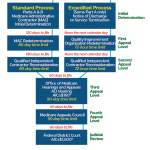In March of 2008, by Section 302 of the Tax Relief and Health Care Act of 2006, the Centers for Medicare and Medicaid Services’ (CMS) Recover Audit Contractor (RAC) program was made a permanent addition to the Centers’ goal preventing fraud, waste, and abuse in the Medicare system.
Looking forward, CMS aims to develop a RAC program in all 50 states by 2010, and it will be of great benefit for practicing rheumatologists—and their office staff—to become familiar with the program.
Section 306 of the Medicare Modernization Act of 2003 directs CMS to use RACs to identify and recoup Medicare overpayments and underpayments, and the RAC demonstration project (held in California, Florida, and New York) was developed to discover improper Medicare payments that were not identified through existing error detection and prevention program efforts.
Preparing for the RAC
The best action a practice can take is set to up an internal plan on how to address the RAC. The ACR recommends that your practice considers performing an internal audit of past filed claims. Here are some tips on how to prepare for the RAC.
- Evaluate your practice to identify any past improper payments, and visit the RACs’ Web site to view a list of the most common errors;
- Put in place an action plan on how your practice will respond to a RAC’s request for any medical records;
- Set up a system on how to file an appeal before the 120-day deadline; and
- If a problem is identified, determine and document what corrective actions have been put in place to ensure proper coding in the future.
According to CMS, in 2005–2007, the project collected—from physicians alone—more than $20 million from overpayments. Most of these overpayments were from specialists, and rheumatologists were in the top percentage among this group.
Under the demonstration program, RACs reviewed the last four years of provider claims. The RACs use automated software programs to identify potential payment errors in areas such as:
- Duplicate payments;
- Medicare carrier mistakes;
- Medical necessity; and
- Coding.
RACs will primarily identify physician overpayments and underpayments through two claim review methods: automated review and complex review. Automated reviews occur when a RAC makes a claim determination at the system level without human review of the medical record. RACs may use automated review when making coverage and coding determinations only when both of the following occur:
- There is certainty that the service is not covered or is incorrectly coded; and
- A written Medicare policy, article, or sanctioned coding guideline exists.
- Complex reviews occur when a RAC makes a claim determination using human review of the medical record. RACs will use complex review when one of the following occurs:
- Requirements for automated review are not met;
- There is a high probability (but not certainty) that a service is not covered; or
- No Medicare policy, article, or sanctioned coding guideline exists.
Moving forward, the states will be divided into four geographic regions. There will be one RAC assigned to each region. Rheumatologists can find out what region they will be in, and when the RAC will be rolled out in their state by visiting the CMS Web site at [email protected].
If you have questions, contact Melesia Tillman, CPC, CCP, at (404) 633-3777, ext. 820 or via e-mail at [email protected].

